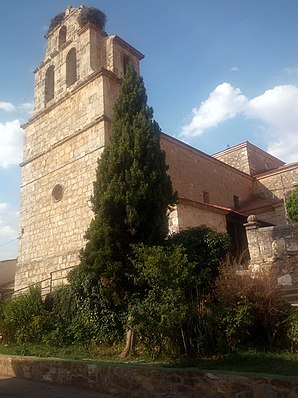Castrillo de la Vega
| Castrillo de la Vega municipality | ||
|---|---|---|
 Castrillo de la Vega - Iglesia de Santiago Apóstol
|
||
| coat of arms | Map of Spain | |

|
|
|
| Basic data | ||
| Autonomous Community : |
|
|
| Province : | Burgos | |
| Comarca : | Ribera del Duero | |
| Coordinates | 41 ° 39 ′ N , 3 ° 47 ′ W | |
| Height : | 810 msnm | |
| Area : | 26.42 km² | |
| Residents : | 621 (Jan. 1, 2019) | |
| Population density : | 23.5 inhabitants / km² | |
| Postal code : | 09391 | |
| Municipality number ( INE ): | 09085 | |
| administration | ||
| Website : | Castrillo de la Vega | |
Castrillo de la Vega is a town in northern Spain and a municipality ( municipio ) with around 621 inhabitants (as of January 1, 2019) in the south of the province of Burgos in the autonomous community of Castile-León .
Location and climate
The place Castrillo de la Vega is located on the south side of the Duero Valley at an altitude of about 810 m . The city of Burgos is about 90 km (driving distance) north; Aranda de Duero is a good 9 km to the east. The climate in winter is often harsh, but in summer it is mostly temperate and warm; Rain (approx. 460 mm / year) falls mainly in the winter half-year.
Population development
| year | 1857 | 1900 | 1950 | 2000 | 2017 |
| Residents | 922 | 1,157 | 1,275 | 592 | 632 |
The phylloxera crisis as well as the mechanization of agriculture and the abandonment of small farms have led to a lack of jobs since the beginning of the 20th century and, as a result, to an emigration of a large part of the population ( rural exodus ).
economy
In earlier times, Castrillo de la Vega was a largely self-sufficient farming village in the Duero Valley; however, the wines produced here could be shipped across the river to Porto and from there to England and Northern Europe. The place is now part of the Ribera del Duero wine region .
history
No evidence has yet been found from the Celtic , Roman , Visigothic and Islamic periods. In the 8th and early 9th centuries, the area was under Islamic-Moorish influence, but the area was neither permanently settled nor defended to a greater extent by the Berbers due to the unusually harsh and rainy climate . At the end of the 9th century, the Castilian Count Diego Rodríguez Porcelos received from King Alfons III. of Asturias the order to repopulate ( repoblación ) the depopulated land. From around 910 until the end of the Caliphate of Córdoba (1031), the Duero formed the boundary between the Christian sphere of influence in the north and the Islamic sphere in the south. Around the year 912, however, the Castilian Count Fernán González conquered the area of Haza south of the Duero ; it was subsequently fortified with castles (castillos) .
Attractions
- The only attraction of the place is the 17th / 18th century. Century built and the apostle James the Elder. Ä. consecrated Iglesia de Santiago . The three-part bell gable (espadaña) with the belfry behind it is noteworthy . The nave (nature) has a transept ; the crossing is raised and covered by a star vault . In the high altar there is an equestrian figure of Santiago Matamoros .
- Surroundings
- Only sparse remains of the ruins of the Torre del Monte (or Atalaya de Montecillo 41 ° 39 ′ 39 ″ N , 3 ° 44 ′ 14 ″ W ), a good 4 km northeast of the town center and still clearly visible in 1860 .
Web links
- Castrillo de la Vega - Photos + Info (wikiburgos, Spanish)
Individual evidence
- ↑ Cifras oficiales de población resultantes de la revisión del Padrón municipal a 1 de enero . Population statistics from the Instituto Nacional de Estadística (population update).
- ↑ Castrillo de la Vega - climate tables
- ^ Castrillo de la Vega - population development
- ^ Castrillo de la Vega - History

